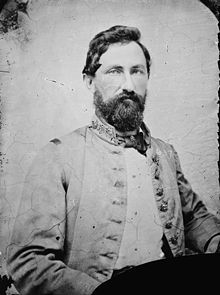William Lewis Cabell
This article needs additional citations for verification. (April 2014) |
William Lewis Cabell | |
|---|---|
 Cabell in uniform, c. 1862 | |
| 14th, 16th and 20th Mayor of Dallas | |
| In office 1874–1876 | |
| Preceded by | Benjamin Long |
| Succeeded by | John D. Kerfoot |
| In office 1877–1879 | |
| Preceded by | John D. Kerfoot |
| Succeeded by | James M. Thurmond |
| In office 1883–1885 | |
| Preceded by | John W. Crowdus |
| Succeeded by | John H. Brown |
| Personal details | |
| Born | January 1, 1827 Dallas, Texas, U.S. |
| Resting place | Greenwood Cemetery, Dallas, Texas, U.S. 32°48′03.6″N 96°47′53.3″W / 32.801000°N 96.798139°W |
| Political party | Democratic |
| Spouse |
Harriet A. Rector (m. 1856) |
| Relations | |
| Battles/wars | American Civil War |

William Lewis Cabell (January 1, 1827 – February 21, 1911) was an American engineer, lawyer, businessman, and politician who served as the 14th, 16th and 20th
Early life and education
William Lewis Cabell was born in
American Civil War
At the outbreak of the American Civil War, Cabell returned to
After leaving Virginia, Cabell was assigned by General
In February 1863, he was placed in command of northwestern Arkansas and successfully recruited and outfitted one of the largest cavalry brigades west of the Mississippi. Cabell led this brigade in over 20 engagements in the Trans-Mississippi Department including prominent roles at the Battle of Poison Spring and the Battle of Marks' Mills where he commanded two brigades under Brigadier-General James Fleming Fagan. He commanded Confederate forces in the Battle of Fayetteville, on April 18, 1863.[1] Cabell was captured in Kansas (by Sergeant Calvary M. Young of the 3rd Iowa Cavalry) during Price's Missouri Expedition on October 25, 1864, at the Battle of Mine Creek and was held as a prisoner of war at the Johnson's Island camp on Lake Erie and then at Fort Warren in Boston.
Later years
After the war, Cabell returned to
Cabell also remained active in Confederate veteran affairs. He oversaw several large veteran reunions and assisted in establishing pensions, veteran homes, and Confederate cemeteries in Texas. He served as commander of the Trans-Mississippi Department of the United Confederate Veterans. William Lewis Cabell died in Dallas on February 22, 1911. 50,000 people lined the streets for a military parade and 25,000 witnessed the ceremony of his burial at Greenwood Cemetery. Before his death, Cabell had converted to Catholicism.[2]
Personal life
Cabell married the daughter of Major Elias Rector of Arkansas; she served as a nurse during the Civil War. Daughter Katie Doswell Cabell, who married a Mr. Currie, followed by Mr. Muse, became president after the war of the Texas Division,
See also
- List of Confederate States Army generals
- List of commanders-in-chief of the United Confederate Veterans
References
- ^ Mahan, Russell, The Battle of Fayetteville Arkansas; Historical Enterprises, Santa Clara, Utah, 2019.
- ^ O'Shea, John (1912). "Texas". The Catholic Encyclopedia. Vol. 14. Robert Appleton Company. Retrieved June 10, 2011.
- ^ Handbook of Texas Online: Charles P. Cabell
Further reading
- Cabell, Randolph Wall. 20th Century Cabells and Their Kin. Franklin, NC: Genealogy Pub. Service, 1993. Print.
- Eicher, John H., and ISBN 978-0-8047-3641-1.
- Entry for Gen. William Lewis Cabell from the Biographical Encyclopedia of Texas published 1880, hosted by the Portal to Texas History.
- Handbook of Texas Online: Charles P. Cabell
- Sifakis, Stewart. Who Was Who in the Civil War. New York: Facts On File, 1988. ISBN 978-0-8160-1055-4.
- ISBN 978-0-8071-0823-9.
